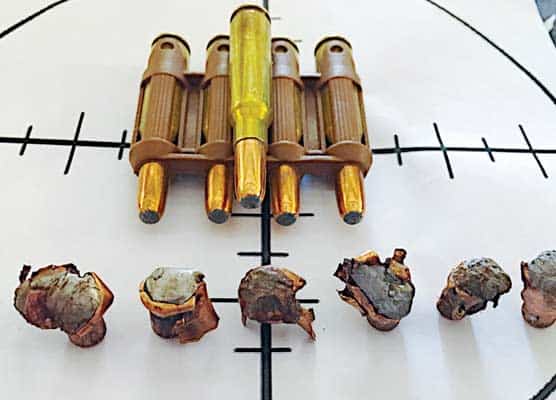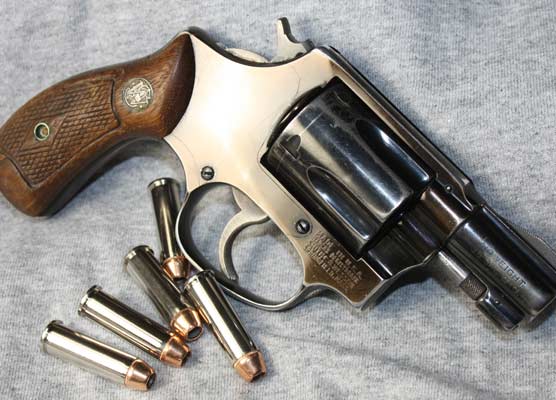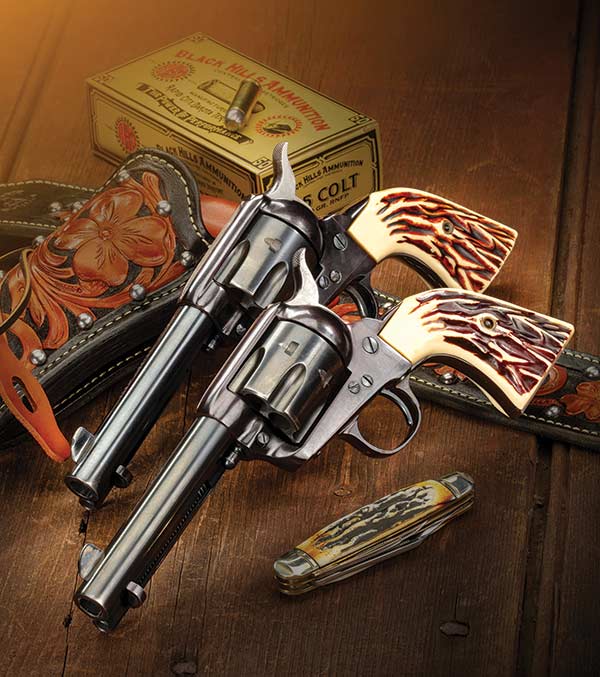On a .41 Frame. . .
Colt’s Classic DA Duty Revolvers
For more than a century Colt and Smith & Wesson have competed for the heart, soul, spirit and mind of American sixgunners. The first swing-out cylinder revolvers appeared in the late 1880’s. Colt was first with the Double Action Army Model in 1889 and then followed with the larger New Service in 1898. Smith & Wesson’s first modern double actions appeared in the mid-1890’s with the Military & Police arriving in 1899 followed by the first N-frame, the Triple-Lock in late 1907.
For more than 50 years police departments relied on either Colt or S&W to supply them with sidearms. Up until World War II, Colt was in the lead, however, after the war S&W began to move ahead and eventually more police officers carried S&Ws than Colts. The number one S&W was the M&P while the top choice among Colts was the Official Police. The race ended with the coming-of-age of semi-autos. Most police departments replaced revolvers with what they considered more modern armament, especially the high-capacity 9mm or .40 S&W.
Roots
The roots of the Colt’s Official Police go back to 1889 with the Model 1889 New Navy. The 1889 Colt came with a speedloader which was soon dropped as being more trouble than it was worth. This revolver was chambered mostly in .38 Long Colt and .41 Long Colt with the latter resulting in this size sixgun being known as a “.41 frame.” Over the next few years, the Model 1889 was improved with the Models of 1892, 1894, 1895, 1896, 1901, and then the 1903 New Army and New Navy. Many of these revolvers were sold to both the Army and the Navy as their name implies as well as to the Marine Corps. Col. Theodore Roosevelt carried a .38 Long Colt in the Spanish American War. This same caliber was found so lacking in power in the Philippines in the early years of the 20th century that it led directly to the adoption of a new pistol. Old .45 Colt Single Actions from frontier service had been placed back into use and then in 1911 the United States Army adopted John Browning’s .45 ACP chambered semi-automatic pistol.
In 1908 all the previous models of the .41-frame double-action Colts were succeeded by the Colt Army Special. These revolvers, mostly chambered in .38 Colt, .41 Colt, and then the more effective .38 Special, were not only sold to the military but also to many police agencies. By 1927, military sales were nonexistent and most of the Colts were going to police departments and the public. The Army Special then became the Official Police.
The “Match”
The Colt Official Police fitted with target sights became the Officers Model Match. Even before this version there was the Officers Model Special and the switch from Special to Match included upgraded sights. The more forward-looking peace officers went with the adjustable sighted Colt with a 6-inch barrel, or for those who preferred the Smith & Wesson, it was the K-38. The .38 Special Officers Model Match has been in competition, or, I should say, was in competition, with the S&W .38 Special K-38 during the heyday of bull’s-eye shooting. I have both versions and by choice I picked the Colt Officers Model Match as the slightly better target sixgun (at least for me).
Most sixgunners agree the S&W is slightly superior to the Colt when it comes to actual double-action shooting; on the other hand, most will also agree the Colt wins when it comes to deliberate single-action fire. There is something about cocking the hammer on the Colt Officers Model Match that simply instills confidence. It is a very special, almost supernatural, feel as that hammer comes smoothly back. Stocks on the Officers Model Match Target .38 are also excellent, being of the target/filler style and fully checkered, giving a very secure comfortable feel in the hand.
Peace officers who chose the longer barreled .38 Specials had to have a holster which could be worn easily in a patrol car. For most the answer was a holster on a swivel, which allowed it to pivot out of the way when seated. Some went even further using a swivel holster that also opened up along the front edge to make access to their gun as fast as possible.
I always find these classic revolvers, be they Colt or S&W, very interesting. Even in this day and age, they still have their place for many of us. They’re not only easy shooting, but exceptionally accurate. When one of these older guns is purchased, usually at quite reasonable prices in a market driven mostly by polymer pistols, it makes you wonder about the history behind it. Once in a while, we are fortunate to learn the history of one of these guns. In this case, one of our readers, J.D. Blair, sent us the following information.
The Man With The Gun
“He came to our small central valley California town from Texas to grab what he could from a country strapped by the Great Depression, first as a grocer, then as a cop. He was average at both but relentless in his efforts to feed a family of five. As a grocer it wasn’t enough and as a cop he was easygoing and kind, but a cop in a small town in the ’40’s could be easygoing and kind and, despite any shortcomings as a policeman, the father was heroic in the eyes of the son.
“In his uniform my father, Terrill, was an imposing figure, showing up at school for ‘play days,’ cheering me on in foot races and high jumps. I stood close to the cop in full police dress while my schoolmates crowded around to see the man with the gun and badge. I’m not sure “pride” describes the euphoric feelings those moments instilled in me.
“The focus of all of the attention of course was his service pistol, the centerpiece of an arsenal on his police belt that included his cuffs and a claw, a flashlight and a sap of woven black leather the texture of snakeskin. The gun was a Colt Officer’s Model .38 Special, serial number 423376. At times when he was cleaning it, I ran my fingers along the barrel where the genesis of the weapon was etched in the blued gunmetal. The Officer’s Special that hung heavy against my father’s aching hip ran with some serious company. Police departments in Los Angeles, New York, San Francisco and several other cities made the .38 Special standard equipment. State police around the country used it and even the FBI eventually made it the standard issue for agents in government service. At 2 pounds, 6 ounces, the pistol felt much heavier in my small hand, when I was allowed to hold it. At some point, my father replaced the standard pistol grips with ivory or bone, strikingly white with what appeared to be small floral etchings and a raised thumb rest.
“The holster that cradled the gun was called “The Speed Holster” made by the Jewett Safety Holster Company in Bakersfield, California. My dad referred to it as a “clam shell.” By pressing a small button dangerously close to the trigger of the gun, the holster would spring open, allowing the gun to be brought straight forward instead of up and out, thus the term “Speed Holster.” Years after my father died, I always found it funny envisioning him as a quick-draw artist. And with the activating mechanism placed so perilously close to the trigger, it was well within the realm of possibility that he could shoot himself in the toe.
“The gun belt, as it sits today, shows the scars left by the everyday wear-and-tear from my father’s waist and holds 10 rounds of ammunition, a mix of Remington, Peters and Western .38 Special cartridges. Those rounds were in the belt when he took it off for the final time. A certain kind of poignancy is attached to that. Even though the pistol has been fired many times since his death, these bullets were never loaded, never fired. Perhaps they are a final and lasting remnant, a legacy of sorts.
“In our town the police department was housed in a small building on the main street with offices in the front and two small jail cells in the rear. There were times when Terrill made his own bullets, and I would go with him to the jail. As he worked making the slugs, he would lock me in one of the cells, perhaps to give me a feel for what it was like and send a silent warning not to flout the law. I watched through the bars and we would talk. He would answer the myriad of questions I had about his work. Today, I suppose those times would be considered our bonding moments.
“After Terrill died, the pistol went to my brother, the eldest son. He eventually passed it on to his son, who has maintained it in near perfect condition. He has fired it many times and claims it shoots flawlessly and true. The bluing is still deep and gleaming, the mechanics well-oiled and fluid and the ivory grips as clean and pristine as the final time they met my father’s palm.”
This classic Peace Officer’s Pistol, hopefully, will always remain with the family and now the provenance is duly recorded in print. This Peace Officers Pistol actually did talk.





